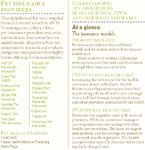Veterinarians soften position on insurance
When it comes to pet-health insurance, a majority of veterinarians are voting for wider use of a third-party payment system.
NATIONAL REPORT — When it comes to pet-health insurance, the majority of veterinarians are voting for wider use of a third-party payment system.
Attitudes about pet-health insurance have been softening over the last 10 years, especially as medical delivery has become increasingly sophisticated and more costly, according to DVM Newsmagazine surveys.

A recession that is spilling into the second quarter of 2009 is hastening the need for a third-party payment system, some say. There are believed to be 15 or more pet-insurance carriers operating in the U.S. animal-health market, and other firms offering financing options to cover the cost of veterinary care.
The issue even spurred a white paper on the subject earlier this year by Brakke Consulting's John Volk and Christine Merle for the National Commission on Veterinary Economic Issues.
DVM Newsmagazine's 2009 State of the Profession survey, more than three-quarters of veterinarians would like to see wider use of veterinary pet insurance. A more modest 58 percent actively recommend it to their clients.
Still, only 1 percent of the pet-owning population is believed to have purchased policies.
Rising costs, according to Volk and Merle, "will trigger more and more health-care crises as pet owners confront veterinary treatment that exceeds their immediate ability to pay."
Dennis Drent, CEO of California-based Veterinary Pet Insurance (VPI), agrees.
In fact, he believes there is a perception gap among consumers about costs of health care overall,
"This perception gap exists because, first, people don't believe anything bad is going to happen to their pet. If something bad does happen, people are ignorant about the costs of veterinary care. We know that veterinarians can do amazing things to bring their pets back to health, but it is expensive. And, third, there is always the option to euthanize the pet. We know that people won't euthanize their pets if they are given options. They will spend the $3,000 to get the pet healthy."
The gap, Drent adds, is perpetuated because most Americans don't understand the true cost of their health care, largely because most employers heavily subsidize the premiums.
VPI's Carol McConnell, DVM, adds that the model for pet-health insurance is quite different from the care offered in human medicine.
Pet-health insurance tyically operates under an indemnity model, which is on the endangered list in human health care now. The model is simple, McConnell says: Pet owners pay veterinarians for services rendered, then submit the bills to the insurance carrier for reimbursement.
NCVEI's white paper says the model is building business for veterinarians. In fact, VPI research conducted in 2006 shows that clients with insurance had 41 percent higher stop-treatment levels, scheduled 40 percent more veterinary visits and spent twice as much on veterinary care over the life of their pet.
On the other hand, wide-scale acceptance of pet insurance by veterinarians has been 30 years in the making. Objections have traditionally focused on concerns over loss of control for patient care or negotiated care that now proliferates in the human medical field. This fear, however, is on the wane. According to DVM Newsmagazine's survey, the majority of veterinarians would like to see wider use of pet-health insurance, and the sentiment is strongest among younger veterinarians. (See the survey results "The Triennial Report: Sizing up generational differences".)
"We believe we are an integral part of the growth of this profession. And I believe there is a one-to-one correlation. The more expensive veterinary medicine becomes, the more people are willing to look into this concept of pet insurance," McConnell adds.
"By all rights," Drent adds, "(pet insurance) should probably be growing much faster than the veterinary world, because the need for pet-health insurance is becoming more and more apparent. The growing human-animal bond married to the sophistication of medical care is making pet insurance a pretty compelling argument."
Episode 29: Using storytelling to retain and attract new veterinary clients
November 19th 2020On this episode of The Vet Blast Podcast, Adam Christman, DVM, MBA, is joined by Australian veterinarian, Phil Tucak, BSc, BVMS, who offers insight on the power of storytelling in marketing your veterinary practice.
Listen




